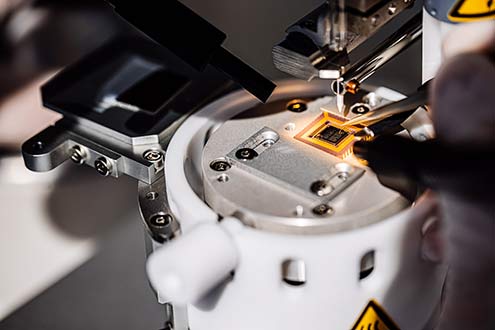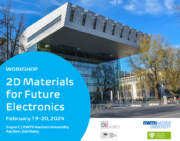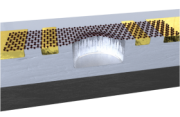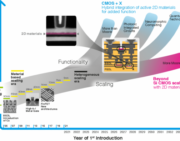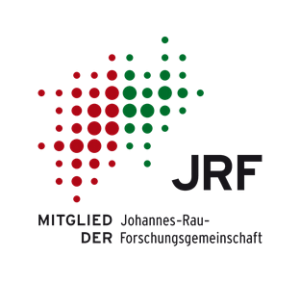The 2D Experimental Pilot Line is at the starting blocks
Bridging the gap between lab-scale manufacturing and large volume production of electronic devices based on two-dimensional materials – this is the mission of the 2D Experimental Pilot Line, a €20 million project funded by the European Commission within the H2020 program. Its kick-off meeting is planned on October 8, 2020.
In 2019, the European Commission invited the Graphene Flagship to set-up a plan for an experimental pilot line for graphene-based electronics, optoelectronics and sensors – a first-of-its-kind experimental manufacturing facility, where European companies, research centers and academic institutions, can produce novel devices based on two-dimensional (2D) materials on a pilot scale.
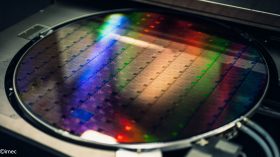
Wafer with integrated 2D materials. Image: imec
The goal of this ambitious undertaking is to demonstrate how to manufacture and scale up the production of devices based on 2D materials in a way that is interesting for market applications. This is a crucial step before graphene technologies can be transferred to full scale manufacturing and, in a sense, the ultimate test for graphene to keep-up with its promises of “wonder material” for electronic applications.
The Graphene Flagship has proposed a consortium consisting of key European players covering the whole value chain, including tool manufacturers, chemical and material providers, and semiconductor fabrication lines: Aixtron Ltd. and Oxford Instruments (UK), imec (Belgium), AMO GmbH, iHP GmbH, Micro Resist Technology GmbH, Aixtron SA and Suss Microtech (Germany), Graphenea (Spain), and VTT (Finland). The project, named 2D Experimental Pilot Line (2D-EPL), will hold its online kick-off meeting on October 8, 2020.
“Two-dimensional materials have unique properties for electronic and photonic devices, as well as for sensors”, says Cedric Huyghebaert, program manager for exploratory material and module integration at imec, and technical leader of the 2D-EPL project. “There are now plenty of publications that show prototypes of devices based on 2D materials with performances significantly beyond the state-of-the-art. But, for bringing these devices onto the market we need to develop tool kits and design manuals for manufacturing them that are compatible with the standards of semiconductor industry.”
The Pilot Line will enable to prototype new devices for electronic, photonic and sensor applications in manufacturing-representative environment. The timeline is ambitious: a baseline process needs to be in place in two years. The experimental pilot-line workflows and protocols should be fully functioning by 2024. The process flow will be validated in state-of-the-art cleanroom environments all around Europe, at AMO and iHP (Germany), imec (Belgium) and VTT (Finland).
To help establishing a European ecosystem for 2D materials covering the entire value chain, the 2D-EPL will be open to the whole R&D community active in the field of 2D materials, exploiting a shared-costs model between users and service providers. The objective is to become a sustainable on-demand service for research and innovation actors in Europe and abroad, integrated into the EUROPRACTICE framework.
“The 2D-EPL really highlights how the European Commission, through projects like the Graphene Flagship, can make an impact in European research, development and industry,” says Graphene Flagship Director Jari Kinaret. “We identified a challenge – upscaling the production of graphene electronics – and the European Commission heard us, finding funding to address this challenge.”
The 2D-EPL project can count on the expertise of the Graphene Flagship team at Chalmers University of Technology (Sweden) for the administrative, business development and dissemination support. The technical and scientific management is led by imec (Belgium) and supported by a core technical steering-group consisting of principle investigators from the integration sites of the pilot line. Furthermore, the project is guided by an Industrial Advisory Board, which comprises key players from the European semiconductor industry, such as AMS, Infineon, and Emberion. The Board will be kept informed about the progress and the solutions developed by the 2D-EPL project and will also provide feedback on industry requirements and specifications, market analyses and early opportunities for the project.
The Pilot Line builds on the existing activities of its partners in the Graphene Flagship and it is closely intertwined with the Graphene Core 3 project. However, its activities are complementary to those developed in other parts of the Flagship and also involve new players. The focus and organization of the new 2D-EPL project are different from that of the Flagship, and closely related to other existing European pilot lines.
“We are very excited to be part of the 2D-EPL”, says Prof. Max Lemme, AMO’s Director and professor at the RWTH Aachen University. “I strongly believe that electronics based on 2D materials can be a vehicle for Europe to gain shares in the high-tech sector. In 2019, RWTH Aachen won a €9 million grant from the BMBF for establishing a new laboratory for research on 2D microelectronics, called 2D-ForMe (2D Materials for Microelectronics). With the 2D-EPL, and local companies like Aixtron, the Aachen region can play a major role in demonstrating the true technological potential of 2D materials.”
The 2D-EPL project is funded by the European Union’s Horizon 2020 research and innovation programme under grant agreement No 952792.

